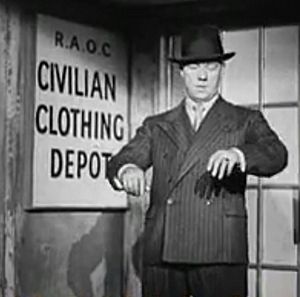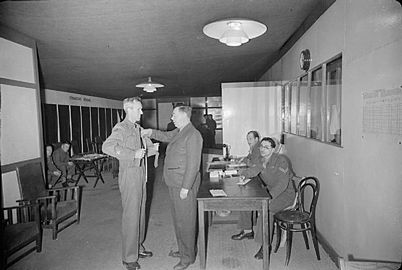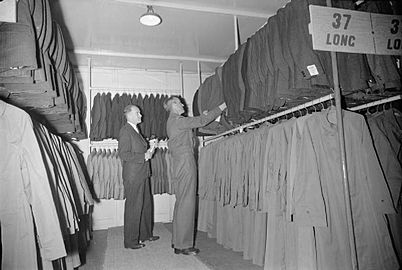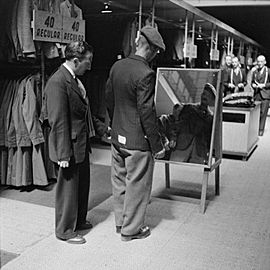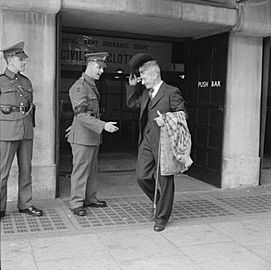Demob suit facts for kids
A demob suit was a special set of civilian clothes given to British soldiers, sailors, and airmen when they left the armed forces after the Second World War. "Demob" is short for "demobilisation," which means returning from military service to civilian life. Millions of men needed new clothes because they had been wearing uniforms for years.
Even though these suits were made from good materials, there were often problems with getting the right size. This was because so many men needed suits at the same time. Because of these funny sizing issues, the demob suit became a common joke in British comedies after the war.
Contents
What Does "Demob" Mean?
The word "demob" is a shorter way of saying "demobilisation." It started being used in the 1930s. Soldiers also received civilian clothes after the First World War, but the phrase "demob suit" became very popular only after the Second World War ended.
Why Were Demob Suits Needed?
After the Second World War, millions of British servicemen began returning home from June 18, 1945. They were released from service in groups, based on their age and how long they had served.
It was very important for these men to get civilian clothes. This helped them fit back into everyday life. Also, after years in uniform, most of them no longer had their old civilian clothes. At that time, clothes were rationed, meaning people could only buy a limited amount. It was almost impossible to buy a new suit from a shop without many special coupons and a long wait.
Special centres were set up by the Army, Royal Navy, and Royal Air Force to help with this. These were called demobilisation centres and civilian clothing depots. The Army's centres were run by the Royal Army Ordnance Corps. One of the Royal Air Force centres was located in Uxbridge.
What Was in a Demob Suit Outfit?
At the demobilisation centre, men were given their new civilian clothes. They were also allowed to keep their military uniforms. The demob suit was just one part of a full set of clothing. According to the Imperial War Museum, a complete outfit usually included:
- A felt hat or a flat cap
- A double-breasted pinstripe three-piece suit, or a single-breasted jacket with flannel trousers
- Two shirts and collars with matching collar studs
- A tie
- Shoes
- A raincoat
Sometimes, other items like gloves, underwear, socks, or even bowler hats were also given out. Men also received extra clothing coupons to buy anything else they needed. They got a special cigarette ration and a train ticket to go home. Many men left the centres still wearing their uniforms, carrying their new demob clothes in a small suitcase.
By late 1945, about 75,000 demob suits were being made every week. A famous clothing company called Burtons was one of the main suppliers. This led some people to believe that the phrase the full monty, meaning "everything" or "a complete set," came from getting a full set of demob clothes from Burtons. Other companies like the Fifty Shilling Tailors and Simpsons of Piccadilly also made these suits.
The demob suits were made from the best materials available at the time. However, there were problems with getting the right sizes to the right places. This meant that men often ended up with suits that didn't fit well or weren't the style they wanted. These issues made the demob suit a source of many jokes. One soldier said his trousers were "unfriendly" because they were too short. Another felt his suit "looked as hostile and intimidating as the bloke pushing it my way."
Men had to take whatever was available when it was their turn. Sometimes, only unusual sizes were left. If a man had a very difficult size, he might get a special custom-made suit delivered later, which often fit better. Because the suits were so common and easy to spot, some men felt like they had just swapped one uniform for another. One man remembered, "I walked proudly into town wearing my light grey pin-striped demob suit, looking around, I recognized all the ex-servicemen—they were all back in uniform—light grey pin-striped suits!"
Some men were embarrassed to wear their suits. One person said he rarely wore his to work because its pattern and color made it obvious where it came from. Still, for many men, this was the first suit they had ever owned. They often wore them for many years after the war for special occasions like christenings or weddings.
Black Market Sales
Because clothes were rationed, there was a high demand for the demob suits and other items on the black market. Small-time criminals, called "spivs," would wait outside the demobilisation centres. They offered men £10 for each set of clothes, and some men accepted. Questions were even asked in Parliament about this. However, the government couldn't do much because the clothes belonged to the ex-servicemen as soon as they signed for them.
In Comedy
The demob suit became a popular topic in British comedy after the Second World War. Millions of people could relate to the idea of a suit that was either too big or too small. This made for obvious funny situations.
The famous British comedian Norman Wisdom, whose suits were always too tight, was demobilised himself in 1946. One critic described him as "Pagliacci in a demob suit," referring to a sad clown. An obituary for Wisdom mentioned his "ill-fitting, half-mast demob suit." Another comedian, Frankie Howerd, who started his career right after the war, often performed in a badly fitting demob suit, probably because he didn't have anything else to wear.
Gallery
Official British Ministry of Information pictures of the demobilisation clothing depot, Olympia, London:
See also



